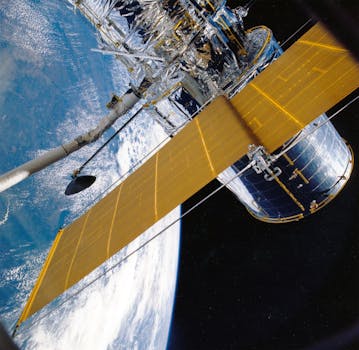From Geostationary to Low Earth Orbit: The Evolution of Satellite Telecommunications in 2023 – Satellite
The satellite telecommunications industry has undergone significant changes in recent years, with a shift from geostationary to low Earth orbit. This article explores the evolution of satellite telecommunications in 2023, including the benefits and challenges of low Earth orbit and the impact on the industry.

From Geostationary to Low Earth Orbit: The Evolution of Satellite Telecommunications in 2023 – Satellite
Satellite telecommunications have been a crucial part of the global communication infrastructure for decades, providing connectivity to remote and underserved areas. The industry has undergone significant changes in recent years, with a shift from geostationary to low Earth orbit. In this article, we will explore the evolution of satellite telecommunications in 2023, including the benefits and challenges of low Earth orbit and the impact on the industry.
Introduction to Satellite Telecommunications
Satellite telecommunications involve the use of satellites in orbit around the Earth to transmit and receive data, voice, and video signals. The first commercial satellite, Intelsat 1, was launched in 1965, and since then, the industry has grown rapidly, with thousands of satellites launched into space. Satellites have played a critical role in providing connectivity to remote and underserved areas, where traditional terrestrial infrastructure is lacking.
Geostationary Orbit
For many years, geostationary orbit (GEO) was the dominant orbit for satellite telecommunications. GEO satellites are placed in orbit at an altitude of approximately 36,000 kilometers, where they remain stationary relative to a fixed point on the Earth’s surface. This allows for continuous coverage of a specific region, making it ideal for applications such as television broadcasting and telecommunications. However, GEO satellites have some limitations, including high latency and limited bandwidth.
Low Earth Orbit
In recent years, there has been a shift towards low Earth orbit (LEO) satellites, which are placed in orbit at an altitude of approximately 160 to 2,000 kilometers. LEO satellites have several benefits, including lower latency, higher bandwidth, and lower costs compared to GEO satellites. LEO constellations, such as those being developed by companies like SpaceX and OneWeb, consist of thousands of small satellites that work together to provide global coverage. These constellations have the potential to provide high-speed, low-latency internet connectivity to underserved areas, as well as to support a wide range of applications, including IoT, 5G, and Earth observation.
Benefits and Challenges of Low Earth Orbit
The shift to LEO satellites has several benefits, including improved performance, lower costs, and increased flexibility. LEO satellites have lower latency compared to GEO satellites, which makes them ideal for applications that require real-time communication, such as video conferencing and online gaming. Additionally, LEO satellites have higher bandwidth, which enables them to support a wider range of applications, including high-speed internet and IoT. However, LEO satellites also have some challenges, including the need for a large number of satellites to provide global coverage, which can increase the risk of collisions and interference.
Impact on the Industry
The shift to LEO satellites is having a significant impact on the satellite telecommunications industry. Many companies, including SpaceX, OneWeb, and Amazon, are investing heavily in LEO constellations, which is driving innovation and competition in the industry. The use of LEO satellites is also enabling new applications and services, such as high-speed internet and IoT, which is expanding the addressable market for satellite telecommunications. However, the shift to LEO satellites also poses some challenges, including the need for new business models and regulatory frameworks to support the development of LEO constellations.





